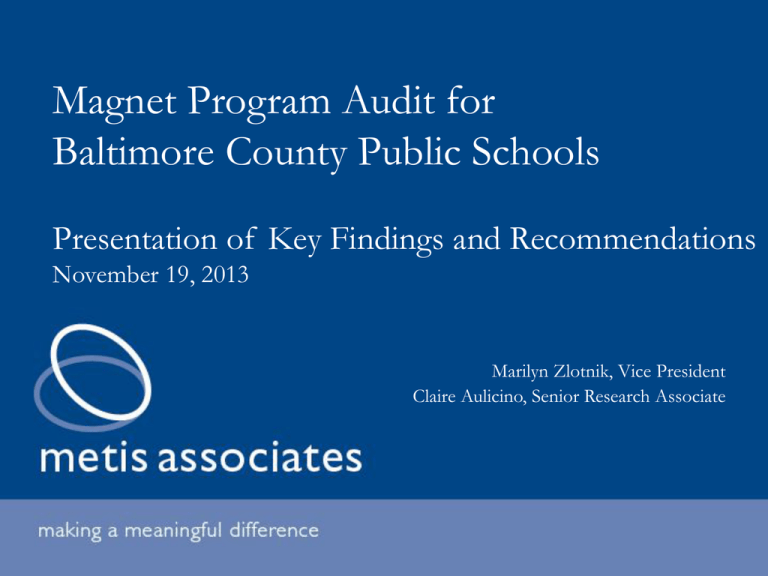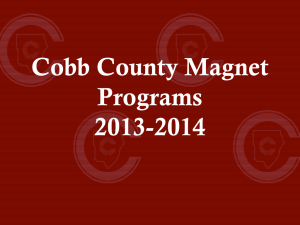BCPS Magnet Audit Board Presentation
advertisement

Magnet Program Audit for Baltimore County Public Schools Presentation of Key Findings and Recommendations November 19, 2013 Marilyn Zlotnik, Vice President Claire Aulicino, Senior Research Associate Presentation Outline • Overview of BCPS Magnet Program • Audit Context • Audit Design and Methods • Key Findings • Recommendations 1 Overview of BCPS Magnet Program • 106 magnet programs serve approximately 12,800 students. – 6 elementary programs (approx. 2,500 students) – 26 middle school programs in 7 schools (approx. 3,500 students) – 74 high school programs in 15 schools (approx. 6,800 students) • First programs were developed in 1993. • Most recent programs additions were in 2003. 2 Audit Context • Audit Timeline: May 1 through October 31, 2013. • Metis Associates was selected to conduct the audit. • Metis Associates is a national research and consulting firm in New York City with more than 35 years of experience in evaluation, information technology, and grant development. 3 Audit Design and Methods 4 Scope of Audit • Equity of Access to Magnet Programs: – Transportation and geographic placement of programs – Admissions criteria and lottery process – Continuity of programs (vertical articulation) 5 Scope of Audit • Effectiveness of Program Implementation: – Program/course offerings and implementation models – Staffing, compensation, and professional development – Budget allocation (school and central) 6 Scope of Audit • Effectiveness of Centralized Administration: – Central staffing – Application and admissions process (including priority placement options) – Marketing and recruitment 7 Data Collection Methods • Key data sources: −Program documentation −Stakeholder input and feedback: 717 staff surveys and 809 community surveys district staff interviews 11 community forums −School and magnet program applicant and enrollment data 8 Key Findings 9 Vision for Magnet Programs • Strength: There is widespread agreement within the BCPS community that magnet programs provide valuable options for students and families. • Area for Improvement: The vision for how the magnet program is aligned with the district’s instructional agenda is not uniformly known or understood by stakeholders. 10 Magnet Program Offerings Strength: BCPS offers an extensive menu of magnet programs and themes across elementary, middle, and high school levels. Areas for Improvement: • There have been very few revisions to the thematic offerings over the past 20 years. • There are not enough opportunities for students to continue themes across school levels (or K-12 pathways). 11 Program Implementation Strength: There is consensus across levels that there is strong support from school-based leaders for the magnet programs. Areas for Improvement: • The scope of exposure to magnet curricula and instruction varies significantly across schools and levels. • There are disparities in the school- and district-based support for programs in terms of staffing and budget. 12 Central Administration and Oversight Strengths: Office of Magnet Programs (OMP) effectively manages the administrative aspects of the magnet program, including implementing marketing strategies that are effective in fostering community awareness of magnets. Areas for Improvement: • OMP does not have sufficient resources to support monitoring of program implementation in each school. • Outreach and recruitment materials may not be accessible to all segments of the community. 13 Access to Magnet Programs Strength: There is a high demand for magnet seats at all educational levels. Areas for Improvement: • There is an uneven geographic distribution of elementary magnet programs and insufficient number of seats to meet the demand. • A complete menu of highly demanded middle and high school magnet themes and programs is not currently offered in each geographic area. • Many students are not eligible for transportation to magnet schools and therefore may not be able to access magnet programming. 14 Participation in Magnets by Subgroups Strength: More than 12,500 students (or 12% of the district population) participate in magnet programs in BCPS. Areas for Improvement: • There is an underrepresentation of students with disabilities in magnet programs at all levels. • Students who participate in magnet programs do not fully reflect the demographics of the school district as a whole. 15 Admissions Criteria Strength: BCPS implements a systematic and fair random lottery to select students who qualify for admissions to magnet programs. Area for Improvement: Access may not be equitable for all students because there is no uniform set of criteria to determine eligibility for admission to secondary magnet programs, as measured by magnet assessments. 16 Recommendations 17 Create Magnet Task Force Create a Magnet Task Force with representation from district and school leaders, teachers, and community members to initiate a strategic planning process to: • Develop a five-year plan for the BCPS magnet program that is aligned with Blueprint 2.0. • Define a clear vision for the role, definition, and value of magnet programs at each academic level. • Incorporate best practices for magnet programs into the plan. 18 Charge to Magnet Task Force 1. Using the vision established for magnet programs in BCPS, develop a proposal for a systemwide portfolio of magnet program offerings that identifies: • Themes that should be expanded, relocated or eliminated. • Opportunities for vertical pathways within each of the three geographic areas of the county (east, central, west). 19 Charge to Task Force (cont.) 2. Implement a systemwide review of magnet curricula and master schedules to: • Establish consistent instructional standards. • Identify curriculum development needs and opportunities for knowledge and sharing of best practices for magnet instruction. 3. Develop staffing and funding recommendations to support high-quality magnet programming. 20 Charge to Task Force (cont.) 4. Define the role for the OMP in administration and oversight of magnet programs and determine appropriate level of resources. 5. Conduct comprehensive review of magnet rules and procedures and develop a plan to ensure consistent application of rules across the system. 21 Charge to Task Force (cont.) 6. Make recommendations to increase equity of access to elementary magnets including expanding, relocating, or eliminating programs and/or increasing number of seats for students without priority placement options. 7. Develop recommendations for implementing highdemand middle school magnet programs in all areas of the county and leveraging effective magnet programs to support district’s ongoing efforts to improve middle school options across BCPS. 22 Charge to Task Force (cont.) 8. Determine the appropriate placement and equal distribution of high-demand high school magnet programs in the east, west, and central areas of the county, including defining the role of Career and Technology Education (CTE) completer programs in the district’s magnet or school choice portfolio. 9. Examine and propose revisions to the district’s establishment of magnet transportation zones to support greater access for all students to magnet programs. 23 Charge to Task Force (cont.) 10. Identify a subcommittee of the Task Force to work with OMP and Communications Office to develop new marketing strategies to ensure greater access to magnet program information for all community members. 11. Identify a subcommittee of the Task Force to examine participation by students with disabilities in magnet programs and work with the Office of Special Education to encourage greater access to magnet programs. 24 Charge to Task Force (cont.) 12. Identify a subcommittee of the Task Force to work with OMP to monitor participation of students by subgroups to ensure equity of access for all students by race/ethnicity, gender, family income, and learning needs. 13. Identify a subcommittee of the Task Force to examine the feasibility of developing a centralized magnet assessment process and create standard assessments for similar magnet programs. 25 Contact Information Marilyn Zlotnik, Vice President P: 212-425-8833 ext. 123 Email: mzlotnik@metisassociates.com Claire Aulicino, Senior Research Associate P: 212-425-8833 ext. 125 Email: caulicino@metisassociates.com 26 27








